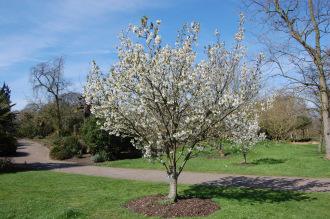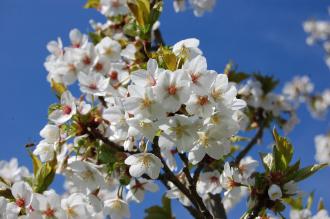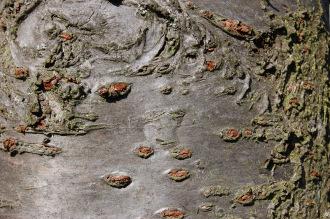
Prunus ‘Umineko’ (21/04/2013, Kew Gardens, London)
Position: Full sun
Flowering period: Spring
Soil: Moist, well drained
Eventual Height: 9m
Eventual Spread: 4m
Hardiness: 6a, 6b, 7a, 7b, 8a, 8b, 9a
Family: Rosaceae
Prunus ‘Umineko’ is a deciduous tree with an upright habit. Its dark green leaves are elliptic with serrate margins, up to 7cm long and 4cm broad. Its leaves turn orange/ purple/ red before they fall in autumn. Its white flowers are up to 25mm across and appear at the same time as its leaves.

Prunus ‘Umineko’ Flower (21/04/2013, Kew Gardens, London)
Prunus ‘Umineko’, commonly known as Umineko Cherry, is a cross between Prunus incisa and Prunus speciosa. Prunus ‘Snow Goose’ is also a cross between these two Cherry species.
The etymological root of the binomial name Prunus is from the classical name of the Plum tree. Umineko is derived from the Japanese meaning ‘Seagull’.
The landscape architect may find Prunus ‘Umineko’ useful as a compact, attractive spring flowering small tree. This tree looks good when planted in avenues due to its regular habit. This tree is tolerant of urban pollution.
Ecologically, Prunus ‘Umineko’ flowers are attractive to pollinating insects.

Prunus ‘Umineko’ Bark (21/04/2013, Kew Gardens, London)
Prunus ‘Umineko’ prefers moist, fertile, well-drained soils. It tolerates most pH of soil. This tree dislikes wet soils.
Prunus ‘Umineko’ requires little maintenance. Pruning should be carried out after flowering, from April to July to minimise the risk of Silver leaf infection.

